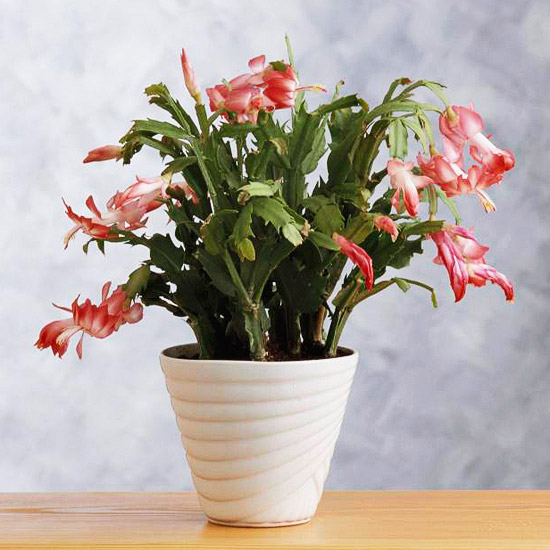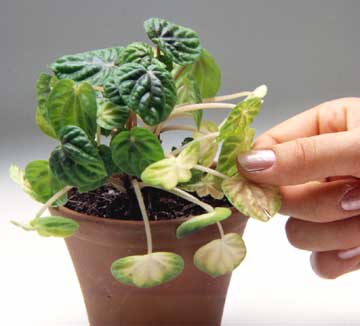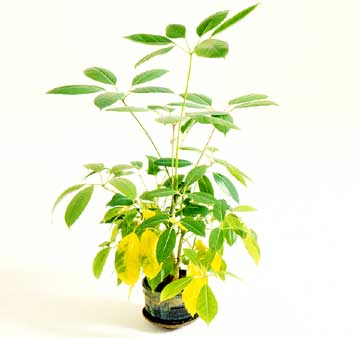





 The Christmas cactus needs shortdays to flower properly.
The Christmas cactus needs shortdays to flower properly.
Light is vital to plants, yet each type of indoor plant, and sometimes individual plants within a type, demand different amounts of it. Each home, too, presents entirely different conditions. That's why you should plan on experimenting with each plant until you find the spot that yields best performance.
There are some general rules, but these all have exceptions. For the most part, flowering plants need more light than foliage plants. Yet croton, a foliage plant, needs lots of light to keep its vibrant leaf color. Most plants with thick, fleshy leaves need little light, yet cacti and succulents thrive in bright light. Some plants flower according to how long light is present each day, rather than how intense it is. Christmas cactus, chrysanthemum, kalanchoe, and poinsettia are examples of plants that need short days (long nights) to flower properly. Fortunately, if other conditions -- water, soil, and humidity -- are right, many plants can live under less-than-perfect light.
Learn how to choose the right indoor plant lights!
To determine the intensity of the light on a given spot in your home, place an object there and check the shadow. The more intense the light, the more defined the shadow. Generally, a south exposure is the brightest. East and west windows can be bright, but usually not as bright as south windows. North windows generally are the dimmest. Light varies considerably by time of year. Light also varies by what's nearby. It can reflect off light-colored buildings or snow, or be blocked by trees, shades, and awnings. Light intensity drops dramatically as you move from the source. Plants near a window receive far more light than ones several feet away, even though the room may be flooded with light.
Click here for more tips on taking care of your houseplants.
High light is found in a greenhouse or by a window with a southern or southwestern exposure. This is intense light, as strong as can be found indoors. It is also called full sun. Medium light refers to direct exposure from an east or west window. Also receiving medium (or what's often called bright indirect) light are spots near a filtered southern or southwestern exposure (or some distance from a similar exposure that's unfiltered). Low light is found near north windows. The light several feet from an east or west window or far from a southern or southwestern exposure (in both cases, often called indirect light) also qualifies as low light. Low light is common in corners and bathrooms. It is not total darkness. Your plants will let you know when the light is not right. Insufficient light causes spindly stems, yellow foliage, and leaf drop. Too much light causes leaf burn or pale foliage.
Download our list of houseplants that do best in high light.
Many houseplants thrive in artificial light. The most effective and inexpensive light source for houseplants is a fluorescent tube. Carefully position plants under the light source (between 6 and 15 inches away). Keep lights on for as many as 16 hours a day, depending on the houseplant.
Flowering plants fail to bud or bloom in poor artificial light. Foliage plants needing more light get tall and spindly. Foliage plants exposed to too much light look ghostly or faded. To increase the light intensity, use more powerful lights, use more tubes, place the tubes closer together, use white reflectors, move plants closer to tubes, or run lights longer.
Match the length of exposure to the needs of the plant. When growing plants under fluorescent tubes, rotate the plants regularly since the light at the end of the tubes is often weaker than in the middle. Experiment with lights from different makers and a combination of fluorescent and incandescent bulbs for a broader color spectrum. But be wary of heat generated by incandescent bulbs; it can burn plants if they are placed too close.
Learn more about plant grow lights.
Learn more about plant lights.
 Unhealthy leaves.
Unhealthy leaves.
This peperomia's sun-bleached leaves -- sickly, lifeless, and colorless -- show the effects of too much intense sun. Remove the lackluster leaves (they won't turn green again) and move the plant away from direct sun.
 Yellowed leaves.
Yellowed leaves.
When mature leaves turn yellow and new leaves grow small and spindly, as on this schefflera, the culprit is too little light, or a lack of fertilizer or water. If the plant is in a room with low light, move it to where it will get more sun.
Click here to learn how to propagate your own houseplants!
Copyright © www.100flowers.win Botanic Garden All Rights Reserved